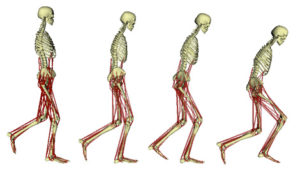Researchers have begun using exoskeletons (similar to Iron Man’s suit) to aid children with cerebral palsy in danger of losing their ability to walk.
The problem…
Cerebral palsy is a developmental disorder that affects the ability to move and maintain balance in the body. This neurological condition caused by damage to the brain before birth affects the body and muscles in ways that make it hard for those affected to walk as they get older. There are several different biological symptoms that lead to the difficulty of walking. According to the Mayo Clinic, these issues can include stiff muscles (spasticity), loose muscles, exaggerated reflexes, lack of muscle coordination (ataxia), and the presence of involuntary muscle movements.
These issues compound as children grow older and the normal movements needed for walking can be lost. Specifically, spasticity leads to continuous contractions causing a permanent deformation of the muscles in the legs. For those with cerebral palsy it is seen in the form of crouch gait (pictured above), where patients’ knees bow inward, It is common for those with cerebral palsy to lose their ability to walk when they reach adulthood due to crouch gait.
The solution…
Researchers from the NIH Clinical Center Rehabilitation Medicine Department looked to attack these problems by using exoskeletons to provide a rigid, mechanical, and guided support for the body. The goal of the exoskeleton was to simply assist the participants by alleviating the muscles’ desire to cause a bending of the knees. However, this needed to be done while the participants still had full control of their own walking.
The exoskeleton was tested on seven patients with cerebral palsy, aged 5 through 19, who had been diagnosed with crouch gait, but still had the ability to walk at least 30 feet without crutches or other forms of assistance. The results showed that patients did not lose their ability to use their own muscles and increased their knee angle positively by an average of 13 degrees and a maximum of 37 degrees. This creates a sturdier posture that is conducive to a longer life of walking.
The future…
The use of an exoskeleton as treatment for crouch gait is both promising and needed. Current treatments include physical therapy, surgery, or the use of muscle relaxers. Physical therapy has not proved to be effective in the long term, while surgery and the injections of muscle relaxers are invasive and painful for patients.
The exoskeleton technology is still young. Researchers want to extend the tested time with their current patients, create exoskeletons that can be used outside of a clinical environment, and attempt to use the technology on those who have already started losing movement.
There is hope that this technology can significantly help these children. Exoskeletons have been used to help restore movement in paralyzed adults during rehab for strokes or spinal cord injuries.
At the 2014 World Cup, a paraplegic man kicked a soccer ball while wearing a robotic exoskeleton. Additionally, researchers at Carnegie Mellon have developed walk aiding ankle bracelets that can be worn outside of a lab and adjust their movements to each user’s needs.
Featured image by Rudy and Peter Skitterians from Pixabay

